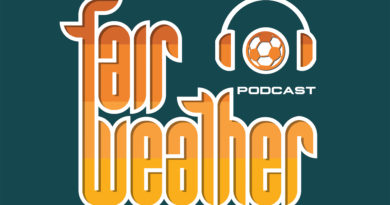Editorial: 30 years after the ADA was passed, disabled fans are still an afterthought in sports
On July 26th, disabled Americans celebrated the 30th anniversary of the passing of the Americans with Disabilities Act, or the ADA. Through this act, American society as a whole, from businesses, to neighborhoods, and even sports teams, had to make changes to become more accessible for their local disabled community.
It’s in the last category that I find myself most involved in and impacted by. As a massive sports fan with Cerebral Palsy, I face barriers when in spaces with other fans who aren’t aware of the ins and outs of how my CP effect me that range from uncomfortable to downright unacceptable.
Language such as “Wow, they know so much about the game for someone who is disabled” might come with good intentions, but under other circumstances, would start a fight, and rightfully so. But believe it or not, disabled people are expected to take this as the height of compliments when they watch sports and can form opinions as well as their abled counterparts. Because many of us are in wheelchairs or have other mobility needs, there are indeed times where we need assistance from abled people. However, this by no means is to say that we are helpless or can’t think for ourselves. While some of these actions seem unbelievable, they’re something disabled people deal with all the time, and go far beyond just simple conversation.
I consider it a privilege to have been able to visit places all over the country and abroad, all the while taking stock of the different things that go into making sports accessible to me and people like me. In too many stadiums, we’re perched high up in the stands or have our sight-lines obscured.
Many teams have come under fire for a lack of disabled seating in their grounds, and push back against detractors, claiming that disabled people pose a fire hazard, or use any other excuse they can to flout legislation, such as ADA regulations in the US or the UK’s Guide to Safety in Sports Grounds.
In a personal experience from October 2018, I visited Raymond James Stadium in Tampa, Florida for an international friendly between the US Men’s National Team and Colombia.
We were ready to enter the stadium ahead of the match, but as we joined the line for entry and approached the steward, we were told to go to the next entrance. Then, after following his instructions, we were told to go to the next one, and had to repeat this again until we eventually must’ve made our way around the entire stadium before finally being able to make our way in. To make matters worse, when we did get to the single disabled entrance, we were in line with abled families with kids in strollers or simply people who didn’t want to use a turnstile entrance.

The whole experience meant that we missed the first ten minutes of the game because the stewards in charge couldn’t do their jobs correctly, and point us to the right entrance with clarity. On top of that, they allowed strollers and people who didn’t need the disabled entrance to exercise their privilege over people in wheelchairs.
Moreover, there have been cases of lawsuits drawn by disabled people against owners of stadiums for lack of disabled seating. In 2007, the Michigan Paralyzed Veterans of America (MPVA) filed a lawsuit against the University of Michigan over the lack of adequate disabled seating at Michigan Stadium, commonly known as the “Big House”, as an act of discrimination. The university had previously come under fire in 1999, and again in 2004, for similar reasons. After inspection from the US Department of Education, UM were forced to make changes to their stadium to follow both ADA Guidelines and the Uniform Federal Accessibility Standards. The school reached a settlement with the MPVA in 2008 and increased their disabled seating spaces from 88, most of which made spectators use binoculars to see the field, to a more respectable 174.
However, the simple fact is that most stadiums, in America especially, place their ADA seating in as an afterthought. As was the case with the Big House of yesteryear, forcing their disabled fans to sit in places that leave them at a great disadvantage for seeing the action on the field unfold. That list of disadvantages includes, but is not limited to, disrupted sightlines, placing them at great height or not giving them ample space to move in what disabled seating there is, despite guidelines against this being prominently displayed in the ADA legislation.
All of this may seem inconsequential, but it goes toward cutting disabled fans off from the atmosphere of the event, which to many, is the reason to attend. Newer stadiums in the country and countries with better disability legislation follow these guidelines more closely, such as Hard Rock Stadium in Miami, Florida, which had been renovated and rebuilt, where I visited for a concert in 2017, which had ramps going up to a separate level specifically for disabled seating around the first level of stands.

Anfield Stadium in Liverpool, England, home to my favorite Soccer team, Liverpool FC, has ground level disabled seating in their famous Spion Kop stand, as well as in the Anfield Road stand directly across. The redevelopment of the stadium’s main stand, completed in 2017, included additions for disabled seating in the other parts of the stadium. This took the total number of disabled seats to 250, and the stadium remains ahead of the curve when it comes to accessibility.

Wembley Stadium, also in England, serves as the country’s premier venue for sports games, concerts and other outdoor events. Opened in 2007, the new Wembley has space for disabled spectators at all five levels of the ground, but it has come under fire for lack of disabled parking spaces, which poses another issue for people in wheelchairs or who have other mobility issues.
However, the fact remains that the age of a stadium and negligent staff should not be excuses for the exclusion of disabled fans. Teams risk losing touch with their disabled fanbase as they continue to ostracize this powerful and important community in more ways than one. Even in promotional campaigns, when it comes to inclusivity, the disabled community aren’t a part of the conversation. People of many backgrounds follow sport, and yet the default person seen in commercials/ad campaigns/social media is straight, white, male and abled. This particular argument is not new within sport, but still excludes the disabled community, when we are amongst the most intersectional communities in the world.
To be truly inclusive to everyone in society, we must always give people with disabilities a seat at the table. Yet sports, something that is continually called “The Great Equalizer” amongst many who love it, continues to neglect and demean some of their most dedicated fans.
To be clear, “a seat at the table” does not only mean changes in the way we think of disabled people, but it requires going to disabled people and asking for feedback, knowledge and insight on how to make their experiences with the teams they love better, both inside and out of the stadium.
Whether that means a refurbishment of disabled seating, meeting with disabled fan groups, or providing more services to their disabled fans, there are always ways to improve a fan’s visit to get behind their team. Disabled fans are like everyone else, and on the face of it, only desire a full and fulfilling game day experience. This is impossible when teams act in direct contrast to the needs of their fans, and that needs to change if we truly desire to be a more welcoming and open minded society. Having sports lead the way in making that change, on and off the field, from fans and teams alike, as it has for many other human rights movements, would be a step in the right direction.





